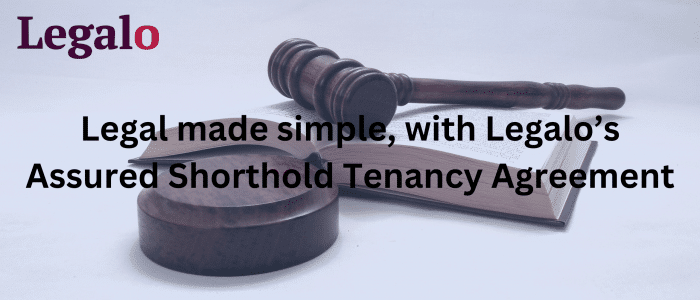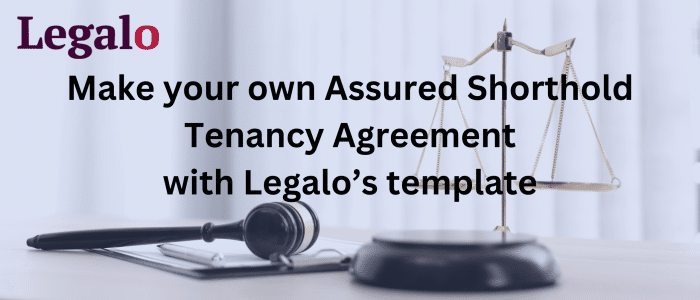Assured Shorthold Tenancy Agreement
Our Assured Shorthold Tenancy Agreement template:
- easy to customise to your requirements
- UK lawyer-drafted template for peace of mind
- full money-back guarantee if not satisfied
- cost-effective legal certainty

How Does It Work?
-
1. Download
-
2. Edit
-
3. Print
-
4. Sign
MD, Legalo Ltd; Solicitor; Notary Public
OUT OF STOCK, PENDING OUR REPLACING THIS WITH A PERIODIC TENANCY AGREEMENT.
This is our standard Assured Shorthold Tenancy Agreement template. It is for use when, as a landlord, you need to put in place a tenancy agreement for the letting of residential property. It is ideal for lettings on a relatively long-term basis (or potential long-term basis), but is suitable for both short term and long term letting of residential property. The “assured shorthold” is the most common basis for such a tenancy. Follow this link if you need to know more about what an assured shorthold basis is usually all about: https://england.shelter.org.uk/housing_advice/private_renting/assured_shorthold_tenancies_with_private_landlords. This type of tenancy agreement puts in place a robust and detailed agreement. You can customise it to suit your individual requirements.
The template has been drafted by David, our co-founder and solicitor of more than twenty years. This ensures that you can rely on the document being up-to-date and legally comprehensive. Our detailed guidance notes (free with the template) offer a clause-by-clause explanation of the document and make producing the final draft quick and easy for you. A copy of the guidance notes are available here: guide to this assured shorthold tenancy agreement.
Tenant Fees Act 2019 – for England only
Under the new residential tenancy laws that came into force on 1 June 2019 for tenancies in England, you should now be following the new rules when issuing new tenancies: The Tenant Fees Act 2019. (Click on the link for details of the changes.) These new rules:
- severely curtail what landlords can charge as extras; and
- set rules on the maximum amount of deposit they can demand from a tenant.
Avoiding anti-social behaviour
If you need an additional policy about the tenant avoiding anti-social behaviour, then we have a separate policy for that.
Using Our Assured Shorthold Tenancy Agreement Template
Once purchased, you can download our template for an Assured Shorthold Tenancy Agreement in Word format at the click of a button. You can then easily edit it to suit your own needs. We offer a full money-back guarantee if you are not happy with your template document for any reason.
Once purchased, you can re-use the template as many times as you want for creating tenancy agreements at no further cost. We keep our templates under review to ensure they are up-to-date. When we update a template that you have bought, we will notify you by email and you will get a free updated template.
Our Tenancy Agreement template is for letting a single residential dwelling to a tenant or tenants. Our agreement can also be used where you want a guarantor for the tenant’s obligations. The tenancy agreement not only comes with a guide to help you fill it out, but also some helpful notices at the start of the agreement on how to deal with it and other related issues, such as holding the deposit in an approved scheme.
Assured Shorthold Tenancies
An Assured Shorthold Tenancy Agreement is a legally binding document for a tenant and landlord to sign. This document is for a specific type of tenancy. The most common type of residential tenancy agreement used in England and Wales is the assured shorthold tenancy. The tenant will have the right to stay in a property for a certain period of time. This is of course subject to their paying the rent and abiding by the terms of the tenancy agreement.
The Assured Shorthold Tenancy typically lasts for six months and up to a year. During that time the landlord cannot evict the tenant without proper cause. After that, the tenancy can roll on from month to month. This continuation is subject to the tenant’s continuing to pay the rent and comply with the terms of the tenancy. If the landlord wants to end the tenancy, he must serve the correct notices. He may also need a court eviction order if the then tenant fails to leave.
To assist you further, we also have available to go with this template:
- an Inventory form;
- a Pet Policy; and
- an Anti-Social Behaviour Policy.
If you would like to see the full range of our residential property templates click on this link.
FAQs on ASTs
Below we answer the top FAQs from the Internet on ASTs.
What is an assured shorthold tenancy agreement?
Typically applying to private residential rentals, an assured shorthold tenancy agreement is a rental contract guaranteeing certain legal protections to tenants, therefore providing security and stability, while also allowing some flexibility for landlords. It grants the right to remain in the property for an initial fixed term, usually six to twelve months, until the end of the term when the landlord can then regain possession under specific grounds, following proper legal procedures. Alternatively, if the landlord and tenant are happy for the tenancy to continue, then either:
- it rolls on month to month as a periodic tenancy; or
- the parties sign a fresh AST for a fixed period of, again, usually 6 months.
Can I write my own tenancy agreement?
Yes, you can write your own tenancy agreement, and you don’t necessarily have to hire an expensive solicitor. With our template, you can draft a contract yourself, without having to worry about all the legal stuff. Drafted by Legalo co-founder David, the reliable template has all the info you need to create a legally binding contract, thus minimising the risk of disputes in the future and providing clarity to both landlord and tenant. Our template saves you time and worry.
What would you find in a typical assured shorthold tenancy agreement?
There are several vital pieces of information to include in an Assured Shorthold Tenancy Agreement. The contract must include details on rent, deposit, notice periods, and responsibilities, as well as outlining the length of the fixed-term residential tenancy. By using our professionally-drafted template, you can be sure that nothing important will be overlooked in this legal document.
Does an assured shorthold tenancy have to be in writing?
In the UK, an assured shorthold tenancy agreement is legally required to be in writing. A verbal agreement will not be enough, as this contract must include written evidence of important details such as rent, deposit, and responsibilities of both landlord and tenant. Writing up such a contract may also prove useful in the future to prevent any misunderstandings when it comes to terms and obligations laid out in the agreement.
Do tenancy agreements need to be witnessed?
It is not legally required to have a witness when signing an assured shorthold tenancy agreement, but it could be useful in cases where disputes may arise in the future. When selecting a witness, it is beneficial to choose an independent and impartial individual who is not linked to the agreement in any way or related to either party. A witness can add evidence and authenticity regarding the agreement, and will be able to confirm that both parties entered into the agreement willingly and without coercion.
How long is an assured shorthold tenancy?
In the UK, an assured shorthold tenancy typically has a fixed term of six to twelve months, so the agreement needs to specify a start and end date. However, this time period is not set in stone. Some ASTs have longer fixed terms (e.g. 24 months), and there is actually no legal upper limit to a tenancy period. While there is no upper limit, a landlord cannot legally evict a tenant less than 6 months into their assured shorthold tenancy agreement period, except for breach of the terms of the AST.
What is the most common tenancy agreement in the UK?
An assured shorthold tenancy agreement is the most common tenancy agreement in the UK. It provides protection for tenants while allowing for flexibility for landlords, so is a useful contract when it comes to private residential tenancies.
Can a landlord end an assured shorthold tenancy early?
Yes, a landlord is able to end an AST early by bringing into effect a section 21 notice, otherwise known as a no-fault eviction. However, this cannot happen during the first four months of a tenancy agreement, and the landlord has to give two months’ notice to the tenant, making it 6 months before the AST can be ended in this way. In addition to these conditions, the landlord needs to follow other legal requirements during this process.
Alternatively, the landlord can terminate and AST before the 6-month limit if there has been a breach of the AST’s terms by the tenant, such as failure to pay rent. For this the landlord uses a section 8 notice to quit.
There is more on eviction in our free guide, “Eviction Notice Templates Explained“.
There is also a useful free guide and checklist from Bristol City Council here.
What is the difference between an assured tenancy and a shorthold tenancy?
When it comes to an assured tenancy and a shorthold tenancy, the main difference lies in the landlord’s ability to regain possession. An assured tenancy agreement provides greater security, with the contract only being terminable on specific legal grounds. On the other hand, assured shorthold tenancy more easily allows for landlords to regain possession of their property once a fixed term is over or through distinct legal procedures (e.g. a section 21 notice).
How does an assured shorthold tenancy end?
There are a few ways in which an assured shorthold tenancy can end:
- Expiry. The fixed term outlined in the contract comes to a natural end. However, the AST then converts to a periodic tenancy, rolling on month to month if the tenant pays rent monthly.
- Notice. The landlord serves a valid section 21 notice and gives the tenant at least the required two months’ notice.
- Legal Grounds. The landlord serves a section 8 notice and obtains a court order, based on grounds, such as non-payment of rent or contract breaches.
- Mutual Agreement. Both parties agree to end the contract before the end of the period.
What happens when a shorthold tenancy expires?
When a shorthold tenancy period expires, there are a few possible scenarios. If the landlord and tenant would like to continue the tenancy, the landlord can issue a renewal with new terms. If the parties take no action, then the tenancy agreement will continue month-to-month as a periodic tenancy, as noted above. When the landlord would like to regain possession of the property, either:
- they can use legal means, such as a section 21 notice, to do so, or
- the tenant can vacate the property when the contract expires.
What rights do assured tenants have?
An assured tenancy contract guarantees several rights to tenants, protecting them in a number of ways. These include security of tenure, fair rent, notice periods, and protection from eviction among others.



